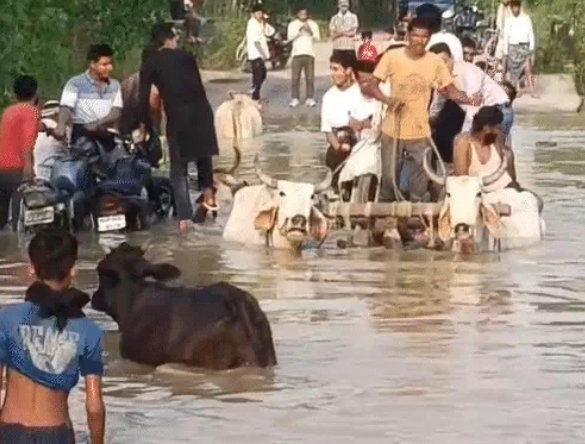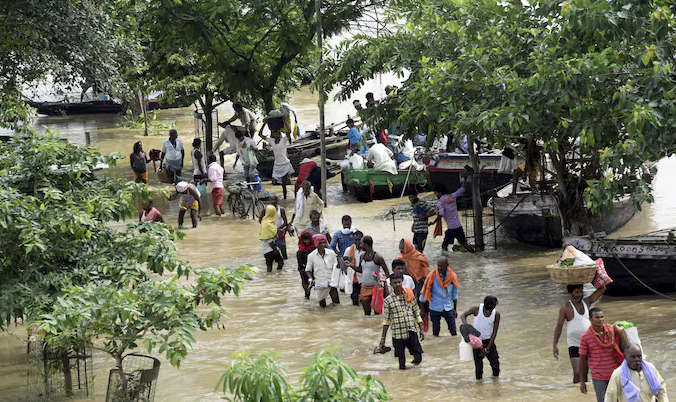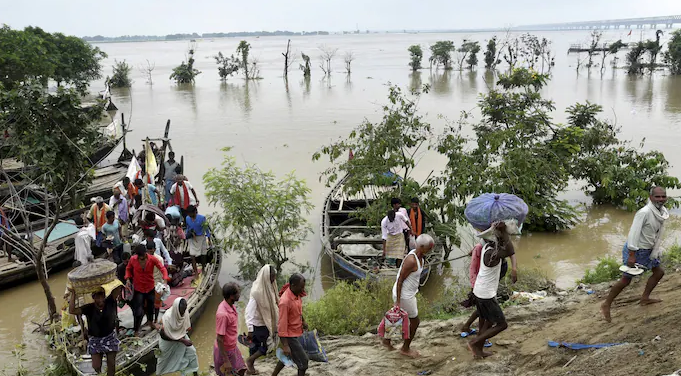Bihar flood 7 districts 10 lakh affected
Heavy monsoon rains and swollen rivers have triggered a major flood emergency across seven districts of Bihar, leaving roughly 10 lakh (one million) people affected — homes submerged, schools closed, roads cut off, and communities scrambling for food, shelter, and medical help. Authorities say multiple rivers are flowing above the danger mark and relief operations are in full swing, but the scale of displacement and damage is already substantial.

What happened — timeline and immediate facts
- When it began: Intense monsoon rains over the past few days, combined with upstream river flows, raised water levels quickly across north and central Bihar. The rise in river levels caused overflow and flash inundation in low-lying blocks.
- Where the impact is concentrated: Seven districts (state bulletins and regional reports identify severely hit districts, including parts of Darbhanga, Begusarai, Bhagalpur, and adjacent areas), with smaller towns, dozens of panchayats, and many habitations either inundated or cut off.
- How many people affected: Official and media bulletins place the affected population at around 10 lakh (1,000,000) people — including those displaced, those with damaged homes, and communities with disrupted services. Some outlets report slightly varying figures depending on the district returns, but the one-million mark is consistently reported.
Human scale: how families, schools and towns are coping
Walking through the flood footprint reveals a pattern seen too often in Bihar’s flood seasons: families wading through waist-deep water carrying bedding and small belongings; school buildings converted to relief shelters; children and elderly huddled with what they could salvage. In several blocks, authorities have ordered school closures and shut Anganwadi centers as floodwaters isolate communities and health risks rise.

Rivers, thresholds and hydrology — what’s driving the flood
Several of Bihar’s rivers — notably stretches of the Ganga, Kosi, and tributaries — are reported to be flowing above the danger mark at multiple points. The Central Water Commission and local hydrology bulletins show readings that pushed rivers beyond safe thresholds in critical stretches, contributing to overtopping, bank erosion, and in places, breaches in embankments. This confluence of heavy local rains and upstream flows is the immediate technical cause of the inundation.
Loss of life and injuries
Local reports indicate fatalities have been recorded in several districts, with drowning and flood-related incidents causing multiple deaths in places such as Begusarai and other hard-hit areas. Numbers vary by district and are being tallied as rescue teams access stranded villages; some media outlets report double-digit casualties in the statewide toll so far. Officials continue search-and-rescue operations to ensure no one remains trapped.
Transport, roads and critical infrastructure
Major highways and district roads have been disrupted in multiple stretches. For instance, flooding on the NH-80 corridor around Bhagalpur has interrupted traffic and hampered early relief logistics. Train services and local public transport have faced cancellations or delays where tracks and approaches are waterlogged. Damage to rural roads and culverts compounds the challenge — small boats become the only transport in many villages.

Agriculture, livestock and longer-term economic hits
The flood comes at a sensitive time for standing crops and harvested produce in low-lying plains. Early assessments from districts point to submerged paddy fields, damaged vegetable crops, and loss of stored fodder — posing both immediate and medium-term food security and livelihood concerns for farming households. Livestock losses and the increased risk of disease in wet conditions further elevate the economic toll. Past flood events in Bihar show recovery can take months or longer for small farmers.
Relief, rescue, and government response, what’s being done
State and district administrations have mobilized:
- Relief camps and community kitchens to feed displaced residents; shelters are being set up in schools and community buildings.
- Boats and rescue teams deployed to evacuate stranded families; local officials report hundreds of rescue sorties in the worst-hit panchayats.
- Medical teams and supplies are being moved to cut-off blocks to prevent outbreaks of water-borne diseases. Public health monitoring is being prioritized where people are congregated in relief centers.
- School closures and suspension of Anganwadi services where flooding risks persist.
Local district magistrates and the state disaster management department have been coordinating relief distribution while urging people in vulnerable areas to move to higher ground. Central agencies and neighbouring states are being kept informed for possible resource augmentation.
Health and sanitation risks, urgent issues to watch
Floods accelerate the spread of water-borne diseases (diarrhoea, cholera, leptospirosis), and create breeding grounds for vector-borne illnesses. Stagnant water, contaminated wells, and crowded shelters raise short-term public health concerns. Authorities typically prioritize potable water supply, sanitation arrangements, and vaccination drives in the immediate aftermath to mitigate outbreaks. Local health departments are on alert.
Eyewitness and ground details
- In low-lying panchayats, residents have been forced onto embankments and road shoulders with their cooking utensils and documents.
- Community kitchens and local NGOs are distributing dry rations; police and local volunteers are assisting with boats and rubber dinghies in areas where roads are impassable.
- Telephone connectivity remains patchy in certain blocks, complicating coordination and the flow of information from remote villages to relief command centers.
(These snapshots are derived from ground reports and district bulletins aggregated by state and regional media.)
Why are the Bihar floods again?
Bihar’s annual flood vulnerability is a product of geography (flat alluvial plains), river systems that drain the Himalaya, and periodic high-intensity monsoon rains. Factors that repeatedly amplify flood damage include embankment breaches, river channel shifts, and downstream pinch-points where excess water cannot disperse quickly. Long-term solutions — such as integrated river basin management, well-maintained embankments, early warning systems, and climate-resilient infrastructure — are frequently recommended by experts but require significant sustained investment and inter-state coordination.
Short-term forecast and outlook
Meteorological and river monitoring agencies warn of continued rainfall and high river inflows in the short term for parts of Bihar and neighbouring catchments. This means water levels could remain high for several days, and rescue and relief teams will need to sustain operations while authorities monitor for possible embankment stress or further overflows. Residents in remaining vulnerable pockets should heed local evacuation orders and official advisories.
How you can help (for readers and community supporters)
- Donate to verified relief funds run by reputable local NGOs and state-authorized bodies — avoid unverified crowdfunding.
- Volunteer locally only if coordinated with district administration; unsolicited volunteers may hamper rescue operations.
- Spread verified information about helplines and relief collection points — misinformation and duplicate requests can derail aid.
- Support longer-term recovery by contributing to rehabilitation funds that help rebuild homes, clinics and schools after waters recede.
What officials say
District officials are publicly urging residents to move to relief camps where food and medical assistance are available. State disaster management teams are coordinating with district administrations to evaluate damage, prioritize evacuation of vulnerable people, and arrange for distribution of relief materials. Official figures on fatalities, property damage, and long-term assessments will be updated as teams complete district-level surveys.
Closing: beyond the immediate crisis
The immediate priority is search, rescue, and relief — saving lives and maintaining public health. The medium-term challenge will be rebuilding livelihoods, rehabilitating farmland, and restoring essential services. This flood, like previous ones in Bihar, shows the human cost of climate-sensitive impacts and the pressing need for resilient infrastructure and stronger early-warning systems.
Stand With Bihar — Every Voice, Every Hand Matters
The Bihar flood in 7 districts affecting 10 lakh people is more than just numbers — it’s families, children, and livelihoods at stake. Stay updated with our verified on-ground reports, share this story to spread awareness, and if you can, contribute to relief efforts through trusted organizations.
Follow us for real-time updates and human stories that go beyond headlines. Together, we can make a difference.




